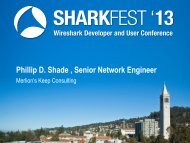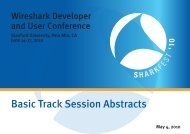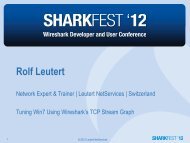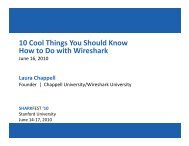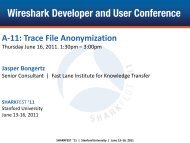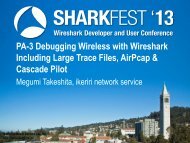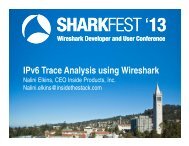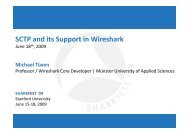How 802.11ac Will Hide Problems from Wireshark - Sharkfest ...
How 802.11ac Will Hide Problems from Wireshark - Sharkfest ...
How 802.11ac Will Hide Problems from Wireshark - Sharkfest ...
You also want an ePaper? Increase the reach of your titles
YUMPU automatically turns print PDFs into web optimized ePapers that Google loves.
<strong>How</strong> <strong>802.11ac</strong> <strong>Will</strong> <strong>Hide</strong> <strong>Problems</strong> <strong>from</strong><br />
<strong>Wireshark</strong><br />
Joe Bardwell<br />
Chief Scientist, Connect802 Corporation<br />
1
Connect802 Corporation<br />
• Your trusted wireless network engineering resource<br />
– Founded in 1994<br />
• Headquarters in San Ramon, CA<br />
• East Coast offices in Knoxville, TN<br />
• Pacific offices in Hawaii<br />
• Complete system implementation<br />
– RF spectrum analysis<br />
– 3D RF CAD design<br />
– Hardware sales and support<br />
– WiFi, medical telemetry,<br />
first responder, point-to-point<br />
www.Connect802.com <br />
2<br />
2/45
Project Portfolio Overview<br />
3/45
You Have a New Baby!<br />
• <strong>802.11ac</strong> is here today<br />
• Market rollout is expected to<br />
occur in phases<br />
– Q1 2013 Consumer Grade<br />
– Q3 2013 Early Enterprise Grade<br />
– 2014 Mid/High Enterprise Grade<br />
– 2015 Peak <strong>802.11ac</strong> demand<br />
• Some <strong>802.11ac</strong> features will not<br />
be implemented until 2014<br />
<strong>802.11ac</strong><br />
6930 Mbps<br />
802.11n<br />
600 Mbps<br />
802.11bg<br />
54 Mbps<br />
4/45
Today’s Challenges with 802.11n Packet Capture<br />
• You can’t capture a MIMO transmission if you’re not standing in the MIMO<br />
“cluster”<br />
– The “cluster” is where the multiple streams converge for recovery by the intended<br />
receiver’s antennas<br />
– You can’t expect to capture 100% of MIMO transmissions in any given environment<br />
• <strong>Wireshark</strong> AirPCap Adapter<br />
– Cannot capture packets with short guard interval<br />
– Cannot capture packets transmitted in Greenfield mode<br />
– Cannot capture 3-stream MIMO<br />
• <strong>Wireshark</strong> with Linux (Ubuntu)<br />
– Does not pass checksums up to <strong>Wireshark</strong> by default<br />
• <strong>Wireshark</strong> on MacBook Air<br />
– This configuration captures all packets properly<br />
• AirMagnet 802.11n PCMCIA Adapter<br />
– Adapter cannot capture 3-stream MIMO<br />
5/45
Overview of <strong>802.11ac</strong><br />
• The <strong>802.11ac</strong> Committee Was Formed in September, 2008<br />
• Advanced Capabilities <strong>Will</strong> Not Be Present In 1 st (or 2 nd ) Release Phase<br />
– Operation only in the 5 GHz ISM band<br />
– Backward-compatible changes to the <strong>802.11ac</strong> packet preamble<br />
– 20, 40, 80 and 160 MHz wide channels (20, 40 and 80 mandatory)<br />
– Up to 8 MIMO spatial streams (only 1 is mandatory)<br />
– 256 QAM modulation (versus 64 QAM in 802.11n)<br />
– Cell capacity of at least 1 Gbps<br />
– Single client throughput of at least 500 Mbps<br />
• FFT of 256 and 512 (up <strong>from</strong> 128 in 11n)<br />
• New PPDUs (Procedural Protocol Data Units)<br />
– Support for the new <strong>802.11ac</strong> preamble<br />
• <strong>802.11ac</strong> uses the same greenfield preamble as 802.11n<br />
– Data for Automatic Gain Control<br />
• Wi-Fi Alliance Compatibility Certification<br />
– Originally Planned for February, 2013 but postponed until<br />
“later in the year” by the WiFi Alliance<br />
“As with 802.11n, <br />
don’t expect all of <br />
the op
Overview of <strong>802.11ac</strong><br />
• 234 OFDM data sub-carriers in an 80 MHz channel<br />
– Versus 108 sub-carriers in an 802.11n 40 MHz channel<br />
• Two 80 MHz channels can be “bonded” together<br />
– 468 sub-carriers are dedicated to a single transmission<br />
• An <strong>802.11ac</strong> access point (with 4 antennas) can simultaneously<br />
transmit to 3 devices downstream at the same time<br />
– Multi-User MIMO (MU-MIMO)<br />
• Beamforming has been standardized<br />
– Consistency in methodology allows compatibility between APs and clients<br />
– A “sounding frame” is transmitted by the access point<br />
– Feedback is provided by client devices to inform the AP about the state of the<br />
transmission channel<br />
7/45
• New modulation methods and channel widths<br />
may prevent packet capture<br />
• You can only capture packets that are<br />
recoverable by your wireless adapter<br />
• You can only capture up to the capacity of<br />
your notebook computer to process packets<br />
8/45
Real-World Capacity Expectations<br />
Maximum <br />
“Connec
Quadrature Amplitude Modulation<br />
8-‐QAM: 3 bits/baud <br />
256-‐QAM: 8 bits/baud <br />
10/45
Challenges with 256 QAM<br />
11/45
MCS Index and FFT Enhancements<br />
• 256 QAM Modulation<br />
– More bits encoded into each signal transition (“bits per baud”)<br />
• 512 FFT (Fast Fourier Transform)<br />
– More granular sampling to recover bits with greater precision<br />
Mandatory for <strong>802.11ac</strong> Support <br />
{Op
Connection Rates by MCS Index<br />
Assume actual data throughput to be roughly 70% of the MCS Index rate <br />
R – Coding Rate N SP –Pilot Symbols N DBPS –Data Bits / Symbol <br />
N BPSCS – Bits/Subcarrier (per SpaXal Stream) N CBPS –Coded Bits / Symbol N ES –Data Field BCC Encoders <br />
N SD –Modulated Data Symbols <br />
13/45
The PLCP Protocol Data Unit (PPDU)<br />
• Physical Layer Convergence Procedure<br />
• Symbol duration: 4 microseconds (Optional 3.6 µs symbol with short guard interval)<br />
802.11n PPDU (Mixed Mode) <br />
<strong>802.11ac</strong> VHT PPDU <br />
1 Symbol = 4μs <br />
L: Indicates Legacy (802.11abgn) Field HT: Indicates 802.11n High Throughput <br />
VHT: Indicates <strong>802.11ac</strong> Very High Throughput SIG: Protec
Things You Can’t Capture<br />
• A receiving adapter will discard any packet that it is unable to recover<br />
– Client devices may support data rates, modulation types, channel width or<br />
MIMO streams that aren’t supported by your capture adapter<br />
• Upstream and downstream data may be transmitted with a different<br />
MCS index<br />
– You may only see one side of a conversation when capturing in <strong>802.11ac</strong> raw<br />
mode<br />
• <strong>802.11ac</strong> cell capacity may exceed a notebook computer’s ability to<br />
buffer received packets<br />
– Client device hardware is designed to support the expected data transfer rates<br />
to and <strong>from</strong> the client device under normal application usage<br />
15/45
• The newest chipsets and radio designs allow for<br />
amazing operational enhancements<br />
• Devices can operate in significantly noisy<br />
environments and access points can detect noise<br />
and interference<br />
• If your capture adapter (and software) can’t perform<br />
as well as the WLAN devices you’ll loose packets<br />
16/45
The Conventional “1-6-11” Channel Rule<br />
Channel 6 overlaps the <br />
three adjacent higher and <br />
lower channels <br />
Channels 12, 13 and 14 are not <br />
used in North America <br />
The “1-‐6-‐11” channel rule <br />
grew out of 802.11bg <br />
channel overlap <br />
consideraXons <br />
Channel 1 <br />
Channel 11 <br />
Channels 1, 6 and 11:<br />
The three “non-overlapping” 2.4 GHz channels<br />
17/45
The WiFi Technology Timeline<br />
802.11<br />
WEP<br />
Failure<br />
802.11h<br />
DFS<br />
802.11n<br />
<strong>802.11ac</strong><br />
Makes Its<br />
Entrance<br />
Into the<br />
Marketplace<br />
Aironet<br />
Acquired<br />
By Cisco<br />
Apple AirPort<br />
(Built-In WiFi)<br />
802.11ab 802.11g<br />
First 802.11a<br />
Products Ship<br />
Google/Earthlink<br />
Metro Wi-Fi<br />
Attempt<br />
Microsoft/Yahoo<br />
Metro Wi-Fi<br />
New York City<br />
There’s been a 9 year evolution in the<br />
sophistication of WiFi RF front-end design,<br />
processing algorithms and chipset<br />
manufacturing since 802.11g<br />
18/45
Evolution of Receiver Architecture<br />
• Adjacent Channel Rejection<br />
– Component examples circa 2001<br />
• IEEE specifies a minimum of 35 dB<br />
• Intel Prism 3 (2001) chipset provided 40 dB<br />
– Component examples circa 2013<br />
Your<br />
Channel<br />
• IEEE allows a minimum as low as -9 dB (adjacent channel is stronger!)<br />
• Circuitry can more accurately recover data <strong>from</strong> noise and interference<br />
Adjacent<br />
Channel<br />
Required SIR<br />
Rejected<br />
Interference<br />
Your Signal<br />
Another Tx On Same Channel<br />
A Tx On the Adjacent Channel<br />
19/45
Dynamic Channel Management<br />
• Access points have become noise- and interference-aware<br />
– Cisco CleanAir with Digital Signal Processor Vector Accelerator (DAvE)<br />
• Custom processing core performing filtering, decimation, rotation, sync-word<br />
detection and modulation detection<br />
– Ruckus ChannelFly<br />
• Real-time throughput measurement on all available channels with dynamic 802.11h<br />
channel switching for all client devices<br />
– Aruba Adaptive Radio Management (ARM) with RFProtect<br />
• Measures non-duty cycle noise floor, CRC errors and other factors to dynamically<br />
change channels for noise and interference mitigation<br />
20/45
Polarization<br />
• The electric field oscillates in the plane of an omnidirectional dipole antenna<br />
– “Vertical Polarization” versus “Horizontal Polarization”<br />
• For maximum energy transfer the receiving antenna must have the same<br />
polarization as the transmitting antenna<br />
– As much as 40 dB of loss can<br />
be measured in the real-world<br />
when antennas are crosspolarized<br />
• The relative polarity between a<br />
conventional dipole antenna and a<br />
hand-held device is unpredictable<br />
• BeamFlex allows for numerous<br />
polarization angles betweenvertical<br />
and horizontal to accommodate<br />
mobile devices<br />
Vertical<br />
Polarization<br />
Horizontal<br />
Polarization<br />
21/45
Things You Can’t Capture<br />
• Expect changes to 2.4 GHz channel planning<br />
– Using 3 capture adapters may no longer be sufficient in 2.4 GHz for 802.11n<br />
(remember that <strong>802.11ac</strong> only operates in 5 GHz)<br />
• Expect dynamic load balancing and channel adjustment<br />
– Client conversations can be moved to a different channel in real-time using<br />
802.11h<br />
• Smart antenna systems may be transmitting a signal that is crosspolarized<br />
relative to your capture adapter antenna<br />
– Your RSSI may be 30 dB less than the desired signal due to cross-polarization<br />
22/45
• 20 MHz, 40 MHz and 80 MHz channel width support is required for an<br />
<strong>802.11ac</strong>-certified device<br />
• The standard specifies the use of 160 MHz wide channels<br />
• Channel width may be a factor that adds to the potential for packet loss<br />
during raw packet capture operations<br />
• The 20 MHz channels that comprise a wider channel can change<br />
dynamically<br />
23/45
ISM Channel Availability<br />
• <strong>802.11ac</strong> Channel Configuration Options<br />
– 20, 40, 80 and 160 Mbps<br />
– DFS is still required in U-NII-2 Extended (Channel 100 – 140)<br />
– A 20 MHz channel is considered “Primary”<br />
24/45
Current ISM Channel Availability<br />
80 MHz 80 MHz 80 MHz 80 MHz 80 MHz <br />
25/45
Dynamic Channel Width Adjustment<br />
• Channel Width Can Change<br />
– Like Dynamic Rate Adjustment<br />
• A 20 MHz Channel is “Primary”<br />
– Non-Primary channels must be reserved prior to<br />
transmission<br />
• Maximum Accepted Channel Width is<br />
Exchanged Between Rx and Tx<br />
– “Operating Mode Notification Action” frame<br />
80 MHz <br />
160 MHz <br />
40 MHz <br />
<strong>How</strong> bad is <br />
the noise? <br />
20 MHz <br />
“Primary Channel” <br />
26/45
<strong>802.11ac</strong> Adaptive Adjustment<br />
• As with 802.11g/n, devices reduce their modulation rates in response<br />
to channel degradation<br />
• Unlike 802.11g/n, <strong>802.11ac</strong> provides the capability of also adjusting<br />
the channel bandwidth (20, 40, 80, 160 MHz wide)<br />
– Channel adjustment is done using smaller transmission segments relative to<br />
the overall configured and allocated channel width<br />
• The channel can also be “split”<br />
– A 40 MHz segment at the bottom of a 160 MHz channel and another 40 MHz<br />
segment at the top of the 160 MHz channel<br />
80 MHz <br />
• Optimal adjustment of both modulation rate and channel bandwidth<br />
can provide as much as an 85% improvement in throughput<br />
compared to modulation rate adjustment alone!<br />
27/45
February 20, 2013 ISM Channel Reallocation<br />
• Keep your eye on the FCC for rule changes<br />
• Manufacturers may want to jump into newly opened frequency space<br />
as a competitive differentiator<br />
As per Docket No. 13-‐49: Revision of Part 15 Rules for U-‐NII Devices – Adopted February 20, 2013 <br />
New channel alloca
What You Can’t Capture<br />
• You will not be able to capture 160 MHz transmissions with an<br />
80 MHz adapter<br />
– There’s every reason to believe that a <strong>Wireshark</strong> capture adapter as well as<br />
all phones, tablets and most notebook computers will be 80 MHz devices<br />
• During a capture session the WLAN controller may adjust AP<br />
channel settings disrupting packet capture<br />
• During a capture session you’ll have clients operating with dynamic<br />
channel width<br />
– Early <strong>802.11ac</strong> deployments are not expected to support dynamic channel<br />
assignment<br />
– Your capture adapter may not support dynamic channel assignment<br />
29/45
• Beamsteering is standardized in <strong>802.11ac</strong><br />
• Circuitry and algorithms for beamsteering are<br />
sophisticated and effective<br />
• Beamsteering and MIMO are often mutually<br />
exclusive<br />
• Multi-user MIMO makes it impossible to capture all<br />
traffic being transmitted in an <strong>802.11ac</strong> environment<br />
30/45
Chipset Beamforming – The Phased Array<br />
Beamforming, also called Beamsteering, allows electronic aiming of the strongest <br />
signal <strong>from</strong> (and the best recepXon angle to) an antenna array <br />
0 0 <br />
λ <br />
Two antennas, transmieng the <br />
same signal, with both antennas <br />
transmieng in-‐phase. <br />
The ½ wavelength separaXon <br />
between the antennas makes the <br />
signal cancel to the leh and right. <br />
Note that the signal starts at 0-‐degrees and is rising <br />
31/45
Chipset Beamforming – The Phased Array<br />
λ <br />
Now the two signals are <br />
180-‐degrees out of phase <br />
but the ½ wavelength <br />
separaXon between the <br />
antennas makes the <br />
signal cancel in the up/<br />
down direcXon <br />
32/45
MIMO Packet Capture Challenges<br />
• Unless you’re in a suitable MIMO “cluster” you<br />
can’t acquire a MIMO transmission<br />
• <strong>802.11ac</strong> is significantly more accurate in<br />
determining how to construct multiple spatial<br />
streams<br />
33/45
The Quantized Steering Matrix<br />
• Channel information is conveyed in a VHT Compressed Beamforming<br />
frame<br />
– SNR for each space-time stream<br />
– Beamforming Feedback Matrix for each carrier<br />
• Up to 56 arrival angles reported for 8X8 MIMO<br />
• The Compressed Beamforming Report<br />
field contains channel matrix elements<br />
• Spatial mapping is performed following<br />
constellation mapping and space-time<br />
block coding of each contributing<br />
transmit stream<br />
“So… I guess all this math stuff means that <br />
<strong>802.11ac</strong> radios need a fast processor and really <br />
high quality hardware…” <br />
34/45
VHT Sounding Protocol<br />
• The environment is “sounded” to create a digital representation of the<br />
state of the transmission channel<br />
– A “Steering Matrix” is the mathematical representation of the current state of the<br />
environment<br />
• Attenuation and phase shift experienced by each spatial stream<br />
• Transmit Beamforming and MU-MIMO require knowledge of the<br />
channel state to compute a steering matrix to optimize reception at<br />
one or more receivers<br />
– Individual space-time streams are<br />
sounded separately<br />
– Training symbols are transmitted<br />
(“Sounding Poll”) and measured by the<br />
recipient station (or stations)<br />
– A channel state estimate is sent back<br />
to the beamformer <strong>from</strong> each station<br />
included in the Sounding Poll for the<br />
derivation of a steering matrix<br />
35/45
Multi-User MIMO (MU-MIMO)<br />
• Downlink only<br />
– Up to 4 users<br />
– Up to 4 streams/user<br />
– Total 8 streams max<br />
• Note that there is NO<br />
beamsteering taking<br />
place in this example<br />
36/45
MIMO With Beamsteering<br />
• To transmit 2 spatial streams with beamsteering would require 4<br />
dedicated antennas<br />
37/45
“Wi-Fi Direct” Connectivity<br />
• Two devices can communicate directly<br />
– Supported by 802.11n but not implemented<br />
– Native support coming in Windows 8<br />
– Google Android will support Wi-Fi Direct over <strong>802.11ac</strong><br />
• Wi-Fi Direct implementations are already in the market<br />
– Samsung Smart Cameras, Captivate Glide, Galaxy S2 and others<br />
– LG Optimus Black<br />
– Sony Bravia TV<br />
– Nook Color CM9<br />
• <strong>802.11ac</strong> Standardizes the Handshake Protocol<br />
– An enabled device advertises an ad-hoc network<br />
– A client connects and obtains WPA2 credentials<br />
• “Wi-Fi Protected Setup”<br />
– Connections can be one-to-one or one-to-many<br />
• Just like conventional access point topology<br />
38/45
Things You Can’t Capture<br />
• You can’t capture more spatial streams than your wireless adapter<br />
supports<br />
• You can’t capture a conversation if you’re not in a compatible MIMO<br />
cluster<br />
• You can only capture 1 conversation out of a possible 4 when MU-<br />
MIMO is in use<br />
• You can’t capture the “hidden” Wi-Fi-Direct transmissions even<br />
though they may impact the capacity of the coverage area<br />
39/45
• For the next few years it’s not anticipated that aggregate cell<br />
capacity (per-AP throughput) will exceed roughly 1 Gbps<br />
– “1300 Mbps” specifications imply roughly 900 Mbps of actual data<br />
throughput<br />
– “1300 Mbps” is a best-case, 3-stream, 80 MHz channel, short guard<br />
interval transmission which is not likely to be the status-quo<br />
40/45
Current Hardware Is Effectively Limited to 1 Gbps<br />
• Cisco 3600 Series: 867 Mbps<br />
• Ubiquiti UniFi Series: 1300 Mbps<br />
Assume actual data throughput to be <br />
roughly 70% of the MCS Index rate <br />
41/45
<strong>802.11ac</strong> Capture Hardware<br />
• Hardware adapters are now available<br />
– PCIe and USB 3.0<br />
– Up to 1300 Mbps, 3X3 MIMO<br />
• <strong>802.11ac</strong> access points can act as capture devices<br />
– Up to 1300 Mbps, 3X3 MIMO<br />
– Requires RPCAP support<br />
– Many commercial-grade APs will provide this support<br />
• Cisco 3600 Series, Ubiquiti UniFi Series<br />
• When 4X4 MIMO and >1Gbps speeds arrive (2015?)<br />
you may need to get a fiber connection to your<br />
notebook computer<br />
– USB 3.0 provides 3.2 Gbps (to 10 Gbps) throughput but it’s<br />
unlikely that more than 3X3 MIMO can be practically<br />
supported in a USB form-factor<br />
– Apple Thunderbolt provides an optical interface of between<br />
5.4 Gbps and 10 Gbps<br />
ASUS AC1750 3X3 Adapter <br />
PCIe Interface 1300 Mbps <br />
{$98.99 on Amazon} <br />
Belkin AC 2X2 USB Adapter <br />
USB 3.0 Interface 867 Mbps <br />
{$50.09 on Amazon} <br />
NetStor External PCIe Expansion <br />
PCI OpXcal Interface 10 Gig <br />
~$1000.00 on the Web <br />
42/45
<strong>Wireshark</strong> And <strong>802.11ac</strong><br />
• New MCS Index and PLCP Header decodes in the RadioTap Header<br />
• New methodologies to account for MU-MIMO and tighter<br />
beamsteering<br />
• Remember that you can only capture packets<br />
that your capture adapter is capable of<br />
recovering <strong>from</strong> the air<br />
– MIMO stream limitations<br />
– MIMO cluster limitations<br />
– MU-MIMO location limitations<br />
– Hardware capacity limitations<br />
“I’ll write the decodes just as <br />
soon as I get <strong>802.11ac</strong> hardware <br />
to play with!” <br />
43/45
“We cannot solve our problems <br />
with the same thinking we used <br />
when we created them.” <br />
-‐ Albert Einstein <br />
Modula
www.Connect802.com<br />
sales@Connect802.com<br />
joe@Connect802.com<br />
(925) 552-0802<br />
45/45




